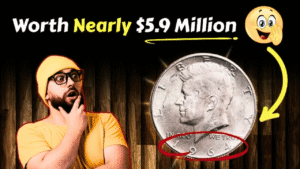Picture finding a quarter in an old jar that’s worth more than a mansion. A retiree in a small town did just that, discovering a 1976 Bicentennial Quarter that sold for $1.4 million at auction. This rare coin, with its unique double die error, proves that life-changing treasures can hide in your attic or pocket change.
What Is the 1976 Bicentennial Quarter?
The 1976 Bicentennial Quarter was minted to celebrate America’s 200th birthday. It features George Washington on the obverse and a colonial drummer on the reverse, with the dual date “1776-1976.” While over 1.6 billion were made, a few with rare errors like the double die obverse are worth a fortune.
The Double Die Obverse Error
This error occurs when the coin is struck twice, slightly misaligned, creating a doubled effect on the design. On the 1976 quarter, look for doubling in “LIBERTY,” “IN GOD WE TRUST,” or the date. These errors are rare, especially in top condition, driving values sky-high.
Why Did This Quarter Sell for $1.4 Million?
Most Bicentennial Quarters are worth just 25 cents. The $1.4 million coin was special due to its double die obverse and pristine condition. Collectors pay premium prices for such rarities, especially from the Philadelphia Mint (no mint mark) or Denver Mint (“D”).
Factors That Boost Value
- Error Rarity: Double die errors are scarce, with only a few known examples.
- Condition: Uncirculated coins with sharp details fetch the highest prices.
- Collector Demand: Competitive bidding at auctions drives up values for unique coins.
The History Behind the Bicentennial Quarter
In 1973, Congress approved a special coin design to mark America’s bicentennial. The U.S. Mint held a nationwide contest, selecting Jack L. Ahr’s colonial drummer design for the quarter’s reverse. Minted in 1975 and 1976, these coins were meant for circulation but became collector favorites.
Production Details
- Philadelphia Mint: Produced 809,784,016 clad quarters, some with rare errors.
- Denver Mint: Struck 860,118,839 clad quarters, known for better strike quality.
- San Francisco Mint: Made 11 million silver-clad quarters for collectors, with some errors.
How to Spot a Valuable 1976 Bicentennial Quarter
Think you have a rare quarter? Here’s how to check:
Step-by-Step Inspection Guide
- Examine the Obverse: Use a magnifying glass to look for doubling in “LIBERTY,” “IN GOD WE TRUST,” or the date.
- Check the Mint Mark: Philadelphia (no mark) and Denver (“D”) coins are more likely to have valuable errors.
- Assess Condition: Uncirculated coins with no wear are worth more.
- Avoid Cleaning: Never polish or clean coins, as it reduces their value.
- Get Professional Grading: Services like PCGS or NGC can verify errors and condition.
Value Chart for 1976 Bicentennial Quarters
| Coin Type | Estimated Value |
|---|---|
| Common 1976 (Circulated) | $0.25 – $1 |
| 1976 MS66/MS67 | $10 – $100 |
| 1976-D Double Die Obverse | $500 – $8,400 |
| Ultra-Rare Double Die (MS68) | Up to $1.4 million |
Other Valuable Quarters to Watch For
The 1976 Bicentennial Quarter isn’t the only one with big potential. Here are other quarters to check:
| Coin Type | Potential Value |
|---|---|
| 1969-S Double Die Obverse | Up to $90,000 |
| 1932-D Washington Quarter | Up to $143,000 |
| 1976-S Silver Proof (MS69) | $500 – $19,200 |
Expert Tips for Coin Collectors
Want to find your own treasure? Try these strategies:
- Search Everyday Change: Check coins from stores, vending machines, or old jars.
- Visit Coin Shops and Shows: Rare coins often surface at local shops or numismatic events.
- Store Coins Safely: Use plastic holders to protect against scratches or wear.
- Join Online Forums: Connect with collectors on Reddit’s r/coins or other platforms for tips.
- Get Coins Graded: Professional grading by PCGS or NGC boosts value and authenticity.
Where to Sell a Rare Bicentennial Quarter
Found a potential gem? Here’s where to sell:
- Auction Houses: Heritage Auctions or Stack’s Bowers specialize in high-value coins.
- Online Platforms: eBay works for lower-value coins, but use high-quality photos and detailed descriptions.
- Coin Dealers: Certified dealers offer fair appraisals and direct sales.
- Coin Shows: Meet collectors and dealers in person for better deals.
FAQs About the 1976 Bicentennial Quarter
Are all 1976 Bicentennial Quarters valuable?
No, most are worth only 25 cents. Only those with rare errors, like double die obverse, or in top condition (MS68) fetch high prices.
How do I spot a double die error?
Use a magnifying glass to check for doubling in “LIBERTY,” “IN GOD WE TRUST,” or the date. The doubling looks blurry or overlapped.
Where can I find rare Bicentennial Quarters?
Look in coin jars, change from stores, bank rolls, or estate sales. Philadelphia and Denver Mint coins are prime candidates.
Should I clean my quarter to make it shine?
Never clean coins. Cleaning removes natural patina and can lower value significantly.
How do I get my coin graded?
Contact PCGS or NGC for professional grading. They’ll assess authenticity, condition, and market value, often increasing its worth.
Conclusion: Your Pocket Change Could Be a Fortune
The $1.4 million 1976 Bicentennial Quarter found in a dusty coin jar shows that treasures are closer than you think. Whether in your wallet, a piggy bank, or an attic box, a rare coin could change your life. Grab a magnifying glass, check your quarters, and start your treasure hunt today—you might be holding a million-dollar piece of history!




